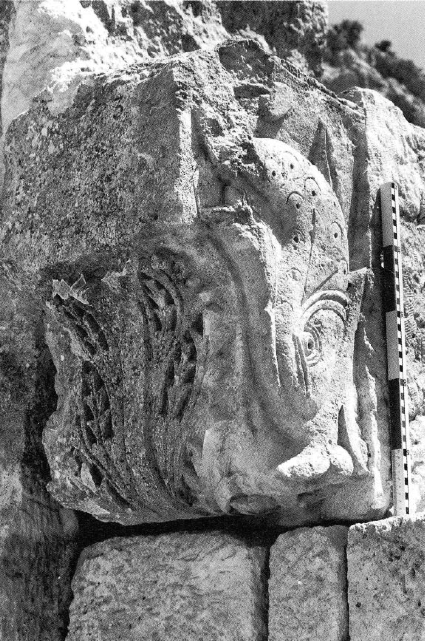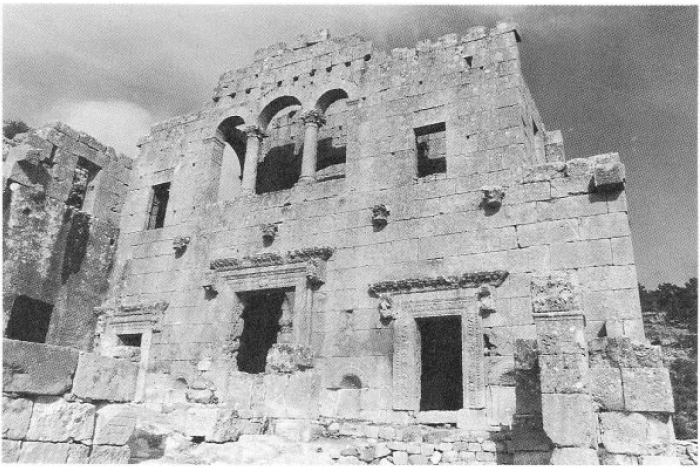Binbir-Kilisse (Lycaonia). Hierapolis: an Intricate Martyr-shrine. Alahan, the Monastic Church
A complex instance of this design is provided by a church recently excavated at Perga. Here a large rectangular courtyard in front of the triple entrance- doorways is balanced, at the further end of the church, by a broad transept having its chancel area marked out by clustered piers with screens in between. The transept has an oblong aisle to the north and south, while on each side of the semicircular apse, separated from it by a massive wall, are matching double chambers approached through openings from the transept.
The colonnaded nave is slender, by comparison, and the emphasis rests with the wide arms and intricate headpiece. Several churches in Lycia, such as those of Karabel and Alacahisar, offer a somewhat different pattern on a small scale. Here the head-piece, attached to a short nave and aisles, consists of a trefoil arrangement of apses, rectangular outside but circular within and linked together by pendentives which uphold the dome. The base of this trefoil is spanned by the main archway which also helps to support the thrust of the dome.
Further east along the coast, in Cilicia, a local variant appears several times, in particular at Corycus and in the vast church built over the tomb of St Theda at Meriamlik (Seleucia) (fig. 89). Each church was entered through a grandiose portico leading to the nave—rather stumpy at Corycus, but immensely elongated, to nearly 35 metres, at Meriamlik. The distinctive feature is the arrangement of the east end, where the apse is flanked on each side by a chapel, or sacristy, shaped like a small basilica with semicircular apse protruding beyond the rectangle. These chapels are extended some distance beyond the main apse to the limit set by a straight north-south wall which therefore marks off an area, put perhaps to no more august use than general storage, between the two side-chapels.

89. Meriamlik, St Thecla: plan of the east end, showing the apse flanked by large side-chapels
Another church at Meriamlik, to be dated at about 480 ad, took the form of a curiously squat basilica where four massive pillars just westward of the apse supported either a dome or, more probably, a tower as at Däg Pazari nearby (fig. 90).

90. Dag Pazari: massive pillars supporting the construction of apse and tower
This type of building is, however, best illustrated by the well-preserved monastic church of Alahan (Kodja Kalessi) lying in remote country further north in Isauria (fig. 91, 92). Here two bays of the nave, nearly half its length, are covered by a rectangular tower.

91. Alahan, the monastic church: a carved capital

92. Alahan, the monastic church
The additional height thus created enables the windows to be set in a top storey with, below them, a repeated arrangement of triple arches springing from columns set one on top of the other and leading respectively into the aisles and into galleries placed above the aisles. The building material consists of large stones carefully cut and seen to particular advantage in the horseshoe arches which straddle the nave. The general air of elegance may perhaps be due to the personal interest of the emperor Zeno, himself an Isaurian, whose calamitous reign was sweetened by a profound concern for doctrinal subtleties and a lively patronage of the arts.
The high lands of the interior of what is now Turkey contain a number of small churches which date from the fifth or early sixth century and exhibit a common pattern of chunky walls and vaulted naves. Hierapolis, as the result of recent excavation, has rather more to show. It was a substantial town on an east-west trade route and enjoyed the prestige of claiming the tomb of Philip the Apostle, so that greater variety and sophistication might well be expected.
The oldest church seems to be an adaptation, made about 400 ad, of a vast hall previously used for some such secular purpose as a bath or a market. Each side of this hall, now the nave, is furnished with three arches leading into vaulted chambers which presumably served as chapels. The construction of the whole is carried out in the Syrian fashion of piling large blocks of stone one above the other on the assumption that they would hold firmly together by their weight alone, while three domes, succeeding each other along the line of the nave, provided both dignity and space for windows.
Another church dating from about the same period is unusual in general design and unique in its detail. Essentially the building consists of a square, a cross and an octagon. The outer part of the square, more precisely a rectangular figure measuring 60 by 61.5 metres, is taken up with an unbroken series of little rooms which may have been private burial-places or lodgings for pilgrims. Four of these chambers, however, one in the middle of each wall, are arranged rather more elaborately, with corner-columns, and are furnished with doorways leading into larger rooms of equal size; these latter rooms thus make up four arms of a cross cut off at the middle by the central octagon.
The eight faces of the octagon are symmetrical: in the space between the four arms of the cross are set rectangular, vaulted chambers corresponding in size to those which compose the cross. The intervening triangles which extend behind the massive piers are filled with little trilobe rooms which, again, look as if they were originally lodgings or burial-places. A system of passageways connects the various members of the complicated but regular pattern. The structure as a whole thus composes an intricate martyr-shrine (fig. 93), and the suggestion, unsupported by any direct evidence, has been made that the octagon marked the traditional site of Philip's tomb, around which those of the faithful who could afford it sought to be buried. The architectural style of this church remains a compromise, however, for the squat piers made up of massive stone blocks contrast markedly with bands of brick and stone in the walling which, together with a lavish use of marble panelling, are characteristic of the Aegean coastland.

93. Hierapolis: an intricate martyr-shrine, perhaps on the site of St Philip's tomb. A few portions of wall that are missing have been reconstructed in the plan
A similar combination of materials is found in another of these majestic tomb-shrines, at Side, in Pamphylia, where, however, the layout is simpler and takes the form of a domed rectangle with a wide, shallow apse projecting from each flank.
The most remarkable collection of churches in the hill country of Asia Minor occurs at the place nicknamed Binbir-Kilisse, Thousand and One Churches', in the province of Lycaonia, where the remote and barren nature of the countryside has given little encouragement to improve on the original structures. About twenty of these remain, varying in size from moderate to tiny and nearly all conforming to a standard 'Syrian' pattern of the late fifth century (fig. 94).

94. Binbir-Kilisse (Lycaonia): a typical church of the district, with barrel-vault and domed apse, seen from the south-east
Externally the buildings are plain and sturdy, the massive blocks of stone relieved only by stringcourses running round windows and doorways. Naves have taken the form of dark barrel vaults, with few windows and these set rather high in the wall. Usually there are aisles, separated from the nave by a row of plain horseshoe-arches on dumpy piers; this arrangement is repeated in the larger arch leading to the apse. The apse, in its turn, projects as a semicircle, covered with a half dome and lit by means of a pair or triplet of windows which once more reproduce, at times rather crudely, the design of the nave arcade. Under grey skies such an accepted pattern of building would be harsh and sombre, but, in brilliant sunshine reflected from rocky hillsides, the group of unpretentious, stocky churches sprang fittingly from their native soil, reserving all they possessed of light and colour to glow around the mysteries enacted within.
Date added: 2022-12-11; views: 918;
